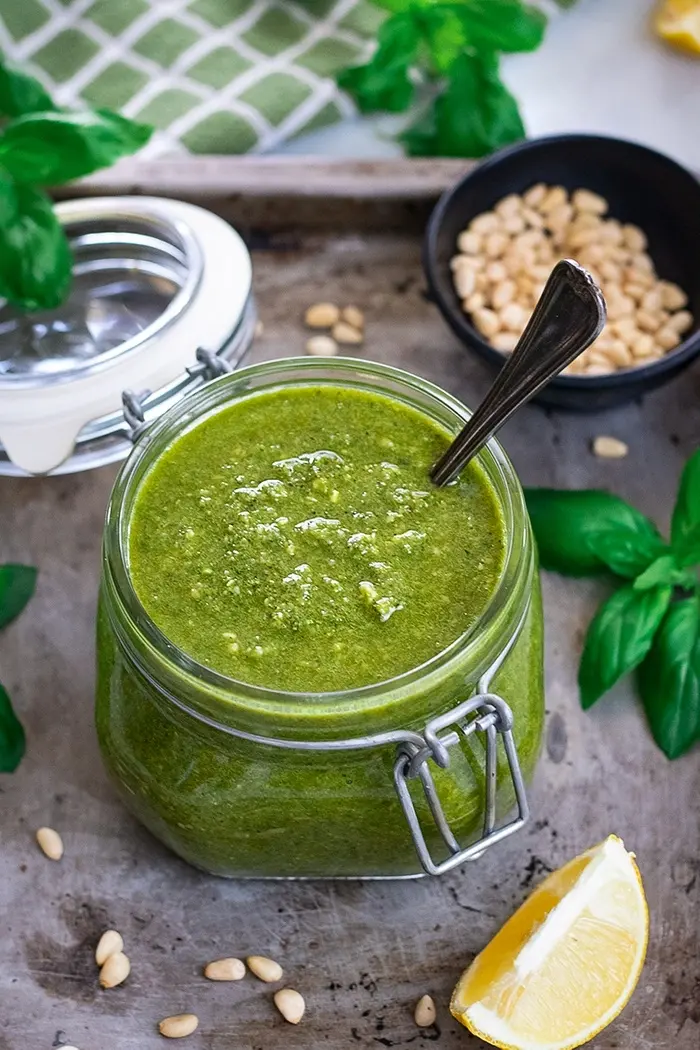Pesto Recipe: Pesto, the vibrant and aromatic sauce originating from Genoa, Italy, has become a beloved addition to countless dishes worldwide. Bursting with fresh herbs, nuts, garlic, Parmesan cheese, and olive oil, this versatile sauce adds a burst of flavor to pasta, sandwiches, pizzas, and more. In this article, we will explore the art of making the perfect pesto and delve into the variations and creative uses of this delectable sauce.
1. Pesto Recipe Essential Ingredients

To create a traditional pesto, you will need the following key ingredients:
a. Fresh Basil Leaves: Choose vibrant, fragrant basil leaves for the best results. Approximately two cups of packed basil leaves will suffice.
b. Pine Nuts: Traditionally used in pesto, pine nuts add a delicate nuttiness. Toast them lightly to enhance their flavor.
c. Garlic: A few cloves of garlic will infuse the sauce with its characteristic pungency. Adjust the amount to suit your personal taste.
d. Parmesan Cheese: Grated Parmesan cheese contributes a rich and salty note. Use high-quality Parmigiano-Reggiano for an authentic taste.
e. Extra Virgin Olive Oil: As the base of the sauce, extra virgin olive oil brings a smooth texture and fruity flavor to the pesto.
f. Salt and Pepper: To season the sauce to perfection.
2. Pesto Recipe Preparation Process

Now that we have our ingredients ready, let’s dive into the preparation process:
a. Start by toasting the pine nuts in a dry skillet over medium heat until they turn golden brown. This will release their oils and intensify their flavor.
b. In a food processor, combine the basil leaves, toasted pine nuts, garlic cloves, and grated Parmesan cheese. Pulse the mixture until everything is finely chopped and blended.
c. Slowly drizzle in the olive oil while the food processor is running, allowing the ingredients to emulsify into a smooth and creamy consistency. Add more olive oil if needed to achieve the desired texture.
d. Taste and season with salt and pepper according to your preference. Remember that the Parmesan cheese already contributes some saltiness, so adjust accordingly.
3. Variations and Creative Uses
While the classic basil-based pesto is a crowd favorite, there are numerous variations and creative uses for this versatile sauce:
a. Spinach or Arugula Pesto: Substitute basil with fresh spinach or arugula leaves for a unique twist on the traditional recipe. These alternatives offer a different flavor profile and can be equally delicious.
b. Nut Variations: Experiment with different nuts such as walnuts, almonds, or pistachios to add a distinctive taste to your pesto. Each nut brings its own character and enhances the sauce in different ways.
c. Pesto Vinaigrette: Thin out the pesto with some lemon juice or vinegar to create a flavorful vinaigrette for salads, roasted vegetables, or even as a marinade for chicken or fish.
d. Pesto Pizza or Sandwich Spread: Use pesto as a delightful alternative to tomato sauce on your homemade pizzas. It also works wonderfully as a spread for sandwiches, wraps, and paninis, providing a burst of freshness and flavor.
The art of making pesto lies in the harmonious combination of fresh ingredients. Whether you stick to the classic basil recipe or venture into exciting variations, pesto is a versatile sauce that can elevate any dish. From pasta to sandwiches and beyond, its vibrant flavors and aromatic profile will surely delight your taste buds. So, grab your mortar and pestle or trusty food processor, and start creating your own homemade pesto masterpiece today.
Read Also: Gazpacho Recipe
![]()






One thought on “Pesto Recipe”